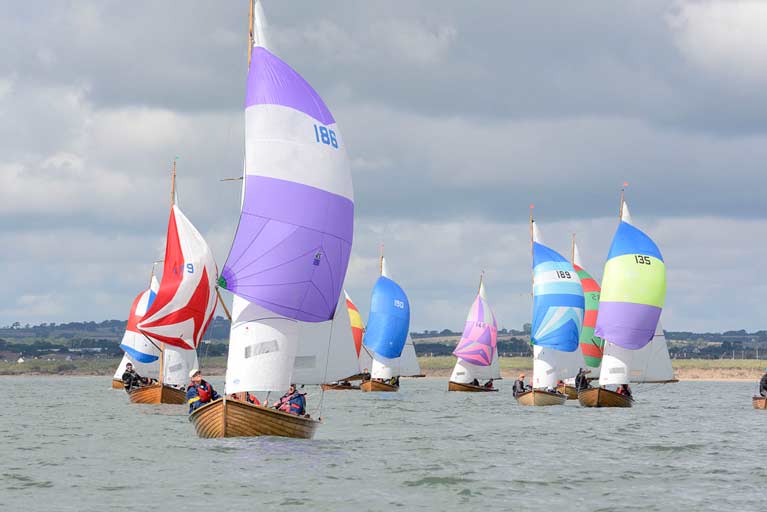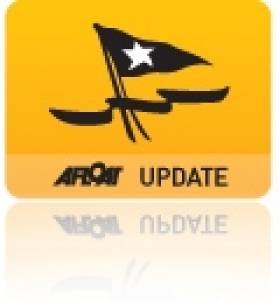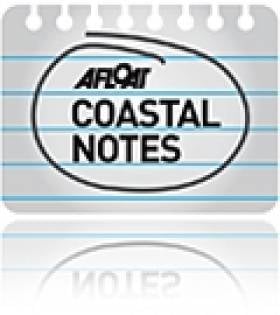Displaying items by tag: Rush Sailing Club
North Dublin's Rush Sailing Club Regatta 2022 will take place next weekend, 2/3 July after an unscheduled break over the last couple of years.
The club will no doubt use the annual occasion to celebrate its success last weekend at Bangor Town Regatta on Belfast Lough when the club's Kelly family lifted the overall prize in their J/109 Storm.
There will be a Caribbean-themed supper after sailing at Rogerstown accompanied by some light music. All are welcome.
 Rush Sailing Club's Kelly family on the podium at Belfast Town Regatta in Northern Ireland after overall success in their J/109 Storm
Rush Sailing Club's Kelly family on the podium at Belfast Town Regatta in Northern Ireland after overall success in their J/109 Storm
Rush Sailing Club was founded in 1954 by a group of passionate local enthusiasts who built their own boats and launched them off the beach on the Rogerstown estuary.
68 years later, the club remains passionate about its sport and now boasts superb facilities, while maintaining the volunteering spirit and sense of community.
The primary aim is to promote sailing and water sports in general, including motor boating, rowing, diving and kayaking.
Last year Rush was boosted two refurbished J/24 keelboats as Afloat reported here.
Please contact [email protected] by this Friday for the regatta entry form and rules.
Every sport sees it happen. Young enthusiastic kids who can't get enough training, competing, fitness, drills, and dreams of making it big writes Paul O'Hare of Rush Sailing Club.
Many then drift away from the sport they loved as they get into their late teens and 20's. Sport gets replaced with studies, college, travel, partners, new careers, marriage, family, and maybe realising that they are not the next Cluxton, Keane, O'Driscoll, or Murphy. Finally, after 10 or 15 years, they get back to the sport they once loved, but now with their own kids.
In sailing, this is an all too familiar story as young sailors, tossed about on the seas of Ireland in single-handed Oppies, Toppers and Lasers, give up the sport during their adolescence. It's hard then to get back into a small dinghy when they are older, so many give up sailing altogether.
Well, the fine people at Rush Sailing Club in North County Dublin have watched this happen throughout the generations, from the club's inception in 1954 to the modern day. They've put together a plan to keep these young adults in the sport by making it exciting, inclusive, competitive and fun. Central to this drive is the club's acquisition of two J/24 racing keelboats. The club chose this popular and competitive boat with 5,500 boats sailing in 165 fleets throughout 110 countries. Crews range from four to six people, and the boat is an ideal all-rounder, offering exciting racing to experienced sailors but a safe introduction to novices (that's right, it has a keel so it won't capsize! Mostly). The boat can be trailered to events and is suitable for all kinds of weather.
 The new Rush Sailing Club J/24's look fast with their new paint job
The new Rush Sailing Club J/24's look fast with their new paint job
The team in Rush are lead by two 20-year old committee members, David Kelly (Sailing Sec) and Lauren O'Hare (Senior Instructor, SI). They are putting together a team racing schedule with the new boats and some other multi-crewed boats that the club own. Team racing draws in members of all ages as Rush family dynasties are pitted against each other. Novices will sail alongside seasoned veterans in a winner-takes-all season. In addition, young crews aim to compete around Ireland & the UK against other clubs in this highly competitive class. The club aims to boost sailing with competition on the water, enhancing the membership experience for all.
 Rush Sailing Club members collecting the boats in Southampton before their renovation
Rush Sailing Club members collecting the boats in Southampton before their renovation
The boats are aptly named 'Juvenile Delinquent' and 'Out of Control'. They were purchased second hand in Southampton at the start of the lockdown, and in typical RSC fashion, they were sourced, collected, gutted and restored by the club's members under the stewardship of Commodore David Kelly (senior). Sponsorship provided by local businesses and members allowed the club to put the boats on the water with zero cost to the membership!
So, if you've never sailed but would love to give it a try, or if you want to get back to sailing, or if you fancy a bit of high-octane competitive fun, then contact RSC, where a new sport, hobby and obsession awaits you.
Three Mermaid Bullets for Boylan at Rush Sailing Club Regatta
The annual Mermaid Rush Regatta took place this weekend with two races held on Saturday the 26th and one race on Sunday the 27th. With a very light forecast given it was looking uncertain whether any racing would be going ahead at all but thankfully a nice breeze filled in and all 3 races were completed as scheduled thanks to an excellent job by Race Officer Liam Dineen and his team.
Download overall results below.
Saturday saw 11 Mermaids heading out to the racing area, navigating the narrow channel out of Rush Sailing Club with a coming tide to wake everyone up! As the majority of boats made their way out more Mermaids began to appear on the horizon, some of the Skerries crew had arrived, sailing ‘around the corner’ to take part. A total of 15 Mermaids got away on a clean start for race 1 and Mark Boylan on 177, This Is It got a great lead from the beginning. Paul Smith on 134 Jill gave him a good race but Mark held onto his lead securing him his first bullet of the day with Paul finishing 2nd and Foynes boat 119, Three Chevrons getting third.
It was fantastic to see an all-female Mermaid competing on the day, number 192 from Rush Sailing Club helmed by Brenda McGuinness with crew Cara McAuley and Ciara Monks who had a brilliant race finishing in 6th place.
Following the first race, a shifting wind and turning tide meant some decisive action was needed from the race committee in order to get a 2nd race in. The race area was moved significantly and once the wind finally decided to stay more or less put allowing a course to be set, a 2nd race got underway with minimal delay. The 2nd race presented a totally new set of conditions and challenges for competitors and it seemed those that banked hard-right up the beat came out on top. Boylan knew exactly where he was going, tacking onto port more or less straight off the line and even ducking a few boats to ensure he got out to the right hand side as early as possible. It paid off hugely and he was again in the lead to the first windward mark.
There was some great close racing amongst the rest of the fleet and it was brilliant to see newcomer to the Mermaids, Darrach Dineen on 36 Elizabeth, finishing in 5th place for this race. Boylan proved uncatchable securing his 2nd bullet for the day with 134 Jill again in 2nd place and local boat 190 Enda Weldon had a great race making up the top 3.
Sunday the 27th saw a lovely breeze of 10-12 knots, beautiful sunshine and mostly flat seas for the third and final race of the regatta. An extra Mermaid joined the fleet for the day, Jonathan O’Rourke on 77 Tiller Girl had come from the National Yacht Club bringing the total number of Mermaids competing up to 16. Boylan on 177 was again in the lead at the first windward mark but 119, Three Chevrons was hot on his heels and a great race ensued between the 2 boats. While Three Chevrons hugely closed the gap, Boylan proved his skill and racing knowledge, holding him off and securing first place, winning him the regatta overall with a flawless 3 bullets.
While 177 and 119 had been battling for 1st place, crafty fox Jonathan O’Rourke had snuck up in the background and expertly called the layline on the finish just pipping 119 to it and getting 2nd place. Speaking to Vincent Mc Cormack from 119 after the race, he described himself as ‘traumatised’ and ‘robbed in broad daylight’ by the light-air ninja Jonathan:
“He only came up here to ruffle everyone’s feathers, he wasn’t even racing yesterday. He should be handicapped when the wind is this light, I was robbed blind! One minute he’s back the fleet and you’re not paying attention to him, then before you know it you’re tacking for the finish and he’s ahead of you, he needs to be monitored, it’s not natural”.
Overall it was an excellent race with a lot of Mermaids finishing within seconds of each other. Final results on the day: Mark Boylan 177 in first place, Jonathan O’Rourke 77 in second and 119 Three Chevrons finishing 3rd. Jill 134 had battled with Jonathan 77 for the majority of the race and secured 4th place. With two seconds and a fourth, 2nd place overall went to Paul Smith on 134 Jill and 3rd place overall at the Regatta went to Vincent Mc Cormack on 119 Three Chevrons.
Congratulations to Mark Boylan with his crew Cliodhna Connolly and Aileen Boylan (crewing Saturday) and Andy Sexton (crewing Sunday) and well done to all involved. It was a great weekend of racing and a perfect way to close out the 2017 season for Mermaids. Congrats also to Anthony Weldon who won a voucher from Mermaid class Sponsor Union Chandlery. While this was the last big event for the Mermaids, club racing will continue for September and even up until October for some clubs with the class.
Rush Sailing Club Makes History in Every Way
There was such a cascade of results from the 190-boat, 208 -ailor Irish Youth Sailing Pathway Nationals at Ballyholme Yacht Club at the weekend that fully analysing the results every which way can go on for as long as you wish writes W M Nixon.
But in addition to the absolutely outstanding runaway win by Justin Lucas of Cork and Tralee in the Optimists, another aspect of note is the way that an eight mile stretch of coastline in Fingal has dominated what might be called the premier class, the Laser Radials.
In youth sailing terms, this is definitely the Grown-Ups’ Game. So when we recall that there are just eight sea miles between Howth Yacht Club at the end of its peninsula at the noted sailing/fishing port, and Rush Sailing Club to the north in its sunny south-facing building beside the swift-flowing waters of the sandy Rogerstown Estuary, it’s intriguing that between them, they filled the top three places in a very closely contested national championship.
Howth’s Ewan McMahon took first at the finish, yet at the early stages the leader was Aaron Rogers of Rush. He had his ups and downs thereafter, but the final race saw a rush of Rushmen as Conor Quinn (of RSC but also of CLYC) put in a stellar concluding performance to place second, while Aaron Rogers got his mojo back to take third
 Mermaids in Rush SC Annual Regatta, 2016. While the Mermaids continue to have one of their strongholds at Rush, the thriving club has a very healthy junior section, and this weekend it stages a Toppers Travellers’ Trophy event
Mermaids in Rush SC Annual Regatta, 2016. While the Mermaids continue to have one of their strongholds at Rush, the thriving club has a very healthy junior section, and this weekend it stages a Toppers Travellers’ Trophy event
They barely have time to pause for breath at Rush, as this weekend sees their staging of a national event in the Toppers Travellers’ Trophy series. And while there’ll also be all sorts of club racing as the season gets into full gear, with the long-established Mermaids playing a key role, another big one coming up the Rush agenda is the Leinster Lasers from 3rd to 5th August.
So the future is bright for Rush Sailing Club. But they’ve special links to the past in addition to their Mermaids. It goes back quite a few years now, to a time when St Marnock’s House in Portmarnock, ancestral home of the James whiskey family who were and are great sailors, had been sold to become a hotel.
It had an old-fashioned glass conservatory which was still in good order, but was too small for the needs of a modern hotel. The word was put out that the intact conservatory was available absolutely for free for anyone who was prepared to come and take it cleanly away. The sailing men of Rush saw their chance, as they were planning a proper clubhouse. They moved the conservatory lock, stock and barrel to the north shore of Rogerstown estuary, and created their hospitable clubhouse around it.
So if you sit in Rush Sailing Club in its sunny south-facing aspect, looking out over the crowded dinghy park and busy anchorage, you’re sitting in a conservatory which was once at the home of the legendary Willie Jameson, who was the hugely successful Royal Sailing Master on the Prince of Wales’s cutter Britannia during her greatest seasons from 1893 to 1897.
 Rush SC’s clubhouse (centre) was built around a conservatory acquired for free when the old Jameson house of St Marnock’s was being re-developed to become the Portmarnock Hotel.
Rush SC’s clubhouse (centre) was built around a conservatory acquired for free when the old Jameson house of St Marnock’s was being re-developed to become the Portmarnock Hotel.
Rush Sailing Club Storm into J109 Nationals Lead off Dun Laoghaire
The blistering upwind pace of Rush Sailing Club entry Storm has given Pat Kelly a two point overnight lead of the J109 National Championships at the Royal Irish Yacht Club. Kelly was fourth in race one but followed this with two well earned race wins in blustery north-westerly winds on the Dublin Bay race track.
Second in the 11–boat fleet is the host club's White Mischief skippered by Tim Goodbody on eight points. 2016 Scottish Series winner, John Hall's Something Else, from the National Yacht Club is lying third.
Defending champion Joker II skippered by John Maybury of the host club is not competing.
Full results to date are below. The championships will be decided tomorrow.
Boylan Aiming to Retain Mermaid Crown at Rush
#mermaid – After falling victim to squally conditions at Rogerstown and with only part of the scheduled sailed to date the pressure is on to complete the Mermaid championship at Rush Sailing Club today.
The championships finally got off to a start on Tuesday with Race one and two being held in what eventually became almost light conditions. Earlier squalls had at times looked ominous but No. 26 Thumbelina and No. 188 Innocence mastered the conditions and each picked up a first. Defending champion Mark Boylan in 177 kept his name in the reckoning with a 3 and a 4. Results to date are downloadable below.
Further racing was scheduled yesterday (no results posted) with the championships concluding today.
Rush Mermaid Championships Hit By Strong Winds
#mermaid – Strong winds gusting to 35–knots forced the cancellation of the first race of the Mermaid Sailing Association National Championships 2014 at Rush Sailing Club yesterday.
The annual event for the three man dinghy class, which typically starts with the Rockabill Trophy as a first race prize was scrubbed as strong winds hit the north Dublin venue. Racing continues this morning (more strong winds are forecast) and runs until 15th August.
Rush Hosts Annual Blessing of the Boats
The annual Blessing of the Boats took place recently at Rush Sailing Club, the North County Leader reports.
Local priest Fr Kieran Coughlan conducted the ceremony, which took place away from the boats this year due to particularly blustery conditions on the day.
Fr Coughlan also led the large gathering in paying tribute to Skerries fishermen Ronan Browne and David Gilsenan, who lost their lives last month.
The North County Leader has more on the story HERE.




































































